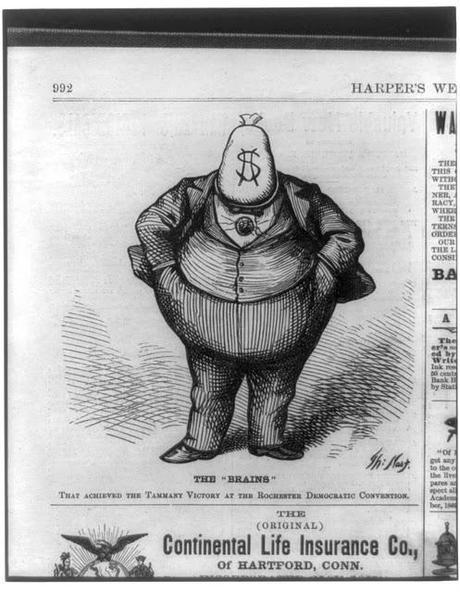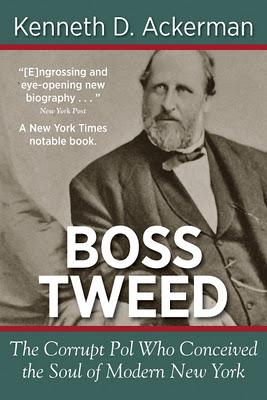
Thomas Nast's lasting image of Boss Tweed as the classic American pol,
from Harper's Weekly, October 21, 1871.
Please don't misunderstand. Stealing is wrong. Graft is bad.
Still, watching today's politicians in Washington tripping over themselves trying to figure out ways to stimulate the economy -- or trying to fix it by cutting back -- I get nostalgic for the master. Bring back Boss Tweed.
William Magear Tweed, Boss of New York's Tammany Hall machine in the 1860s and 70s, controlled mayors, governors, newspapers, and companies. He used his power to steal from the city and county -- for an astounding estimated $100 million (billions of dollars in modern money) during his relatively brief time at the pinnacle.
But Tweed kept his power not just by stealing elections (which he did often). He also used his power to build. Talk about infrastructure? Tweed and his Tammany crowd did more to modernize New York City than anyone else in their generation. Tweed didn't need a "Stimulus Package" to grease the economy. He used the direct method -- graft.
Tweed spent the city into a $100 million deficit, mostly with money borrowed from investors in Europe who had no idea he was cheating them. Most of the cash went to pay politicians and hire legions of laborers. Was some of it stolen? Of course! But along the way, it helped spark an economic boom.

A year after Tweed fell from power, in 1873, a financial panic hit New York and threw the city and country into the worst economic depression of the Nineteenth Century.
Graft aside, Tweed's regime left the city and country wonderfully enriched: Their fingerprints are on every major NY creation of the Gilded Age: Central Park, the Brooklyn Bridge, the Tweed Courthouse, new widened streets and sidewalks, the New York Stock Exchange, the Metropolitan Museum of Art, Mount Sinai Hospital, and dozens of charities. The list is almost endless. And they left a tradition of political inclusion, a "wide tent" approach that modern politicians could only envy.
Except for all the stealing, the frauds and deceit, and the years in prison -- of which there were plenty and which, to be clear, were very very wrong -- he was a great man.
Tweed would know how to get the country moving again in today's financial mess. But don't watch too closely. Tweed's methods were not for the squeamish, and "transparency" was not part of his approach.
For more, see the new Viral History Press edition of Boss Tweed, the Corrupt who Conveived the Soul of Modorn New York.

